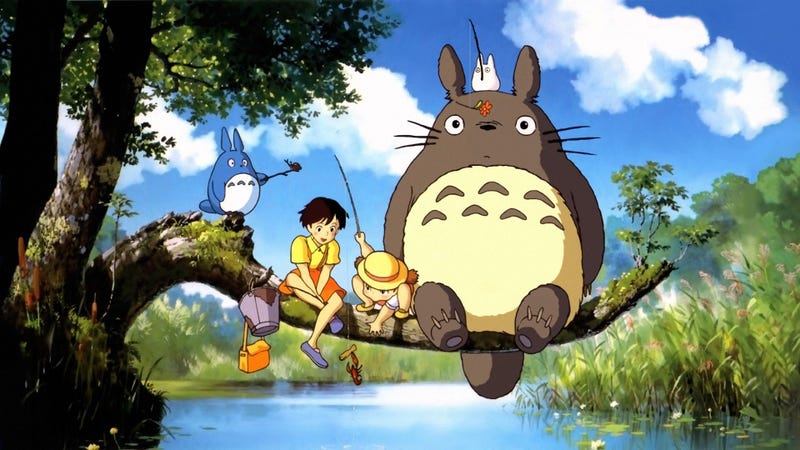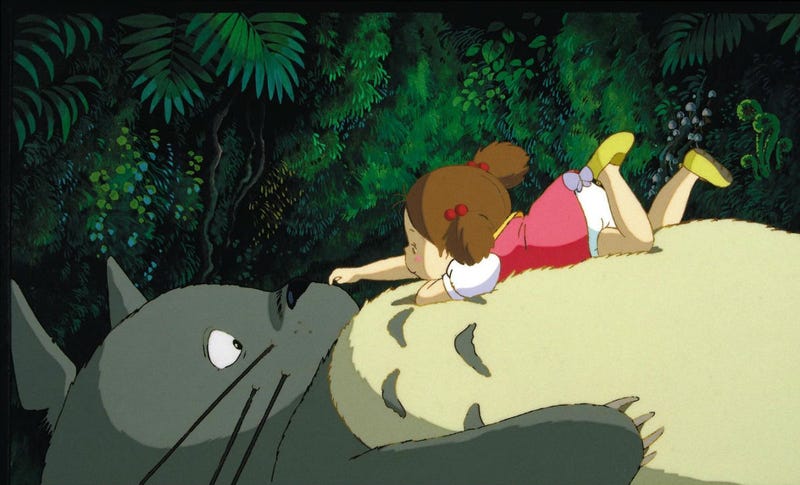
I know I’d seen Hayao Miyazaki’s 1988 film My Neighbor Totoro before I decided to rewatch it recently. I even remember whose DVD I borrowed, and where I watched it. But it wasn’t until 10 minutes into this rewatch that I realized I didn’t remember the film at all. All I remembered were some of its most iconic images.
http://www.amazon.com/Neighbor-Totor...
One of the many things I’d forgotten is that My Neighbor Totoro’s most famous fantasy elements are a minor part of the film itself. At its heart, Totoro is about a family in transition. A father and his two daughters move to a new town and a new house. Later, we find out that the mother is in the hospital and has been for sometime. These sound like sad, scary scenarios but every one of these characters tackle them with an infectious, adventurous optimism. Even when it seems like their house is haunted, the daughters, scream and laugh at the idea. “I’m not scared,” repeats the younger daughter over and over again. And she’s not kidding.

We realize that once again, when she goes into the woods and meets a huge creature she nicknames “Totoro,” after a character in one of her books. Who Totoro is, what he can do or what purpose he serves in the movie is unclear at the start. And, in a way, it’s kind of muddy throughout the whole movie. The character pops in when the family needs help, provides it with a smile and yell, then disappears again. Why is Totoro helping this family? Why is he so willing to summon his amazing Cat-Bus to their aid? Your personal answers to that question are why My Neighbor Totoro is so wonderful.
There are obvious readings, of course. Maybe Totoro is the king of the Forest, like the father suggests, and he helps the family because they’re happy and respectful to him and his friends. But that’s absolutely not the only way to interpret the events. Miyazaki has created a tale where emotion and naturalism allow you to read the film however you’d like to.
Maybe the family is using optimism as a front to cover up their true, sad, emotions and Totoro can sense that. Maybe he just thinks the girls are cute and funny, and is helping them for his amusement. Maybe Totoro doesn’t exist at all, and he’s just something the humans in the story have imagined, to make a terrible situation more bearable. Or maybe he’s just being neighborly, because that’s how people should be to each other, even if they’re on a totally different plane of existence.

Whatever the answer, Miyazaki builds a sense of trust with his audience by grounding almost all of the film in reality. Most of the film feels kind of familiar and small, like you are just watching a simple, family melodrama. So, when Totoro pops in and does something magical, it elevates not just the emotions of the characters, but the emotions of the audience. It’s a release, a laugh, a ray of light in a dark room. The juxtaposition makes the fantasy more fantastic and the reality more real.
And yet, those elements work is a bit like peanut butter and jelly—two different things that go together perfectly. Totoro and the family feel almost wholly disconnected, but also connected at the same time. One is a group of humans, the other a creature who can fly and create magic. Together though, they make each other better and we, the audience, are left to ponder why and how that can be.

By the end of My Neighbor Totoro, you’re left with an example of what Miyazaki does best. He takes a bright, beautiful, recognizable world and infuses it with jaw-dropping, original imagination and wonder. Some of his later films are surely more complex, but the simplicity of Totoro, coupled with its ability to fill your imagination with whatever you want it to be, makes it worth of the accolades given to it by history. I know I was long overdue for a rewatch. Maybe you are, too.